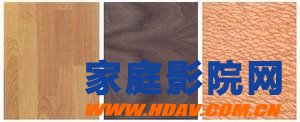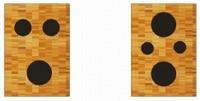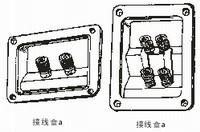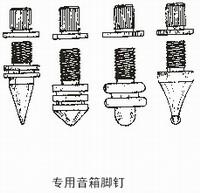[Home Theater Network HDAV.com.cn] The activities of entertainment activities are gradually increasing in our lives. The establishment of home theater has become a trend. Home theaters can bring better sounds to us for better sounds. Sounding equipment is especially important. The audible output terminal is also the most intuitive device, regardless of its sound quality or aesthetics. All tests can be the speakers in our minds.
A pair of ideal speakers, except for the speaker diaphragm, should not vibrate with sound waves. On the contrary, it is mainly caused by the thickness and weight of the box. Therefore, the production of the speaker should take into account the volume and power of the speaker, the greater the air pressure in the chamber, the harder and thicker the board wall, especially the front and rear panels are prone to vibration, the thickness of the board is suitably thicker than Side panel.
The panel of the closed speaker is thicker than the inverted speaker. If it is a low speaker, its box is much heavier than the Hi-Fi cabinet board. Since the thick plate is smaller than the natural resonance of the board, it is best to use a box with a hard texture, a large weight, and a certain thickness.
Because the enclosure is not leaking, the cabinet is too thin to cause resonance. If a certain frequency excites the vibration of the box, the energy at this frequency will be largely consumed in the vibration damping of the board, and thus it is enough to generate a deep valley value, which seriously affects the sound quality. Only thickened box plates can have a significant effect on the box wall resonance and reduce the generation of standing waves.
From the empirical data of the production of the speaker, the relationship between the size of the speaker and the thickness of the box is as follows:
Speaker diameter <12.70cm (5in),
The speaker board thickness should be 16~18mm;
The speaker diameter is 15~20cm (6~8in).
The thickness of the speaker board should be 18~20mm;
The speaker diameter is 25~30cm (10~12in).
The speaker thickness should be 20~25mm;
The speaker diameter is 35.6~45.7 (14~18in).
The speaker board thickness should be 25~30mm.
If the original board is used and its texture is hard, the thickness of the box can be reduced by 10% to 15%.
1. Speaker structure selection

Regardless of which box you choose, you don't want to make an equilateral square, at least avoid the same length, width, and depth. The box is preferably rectangular in shape to avoid standing waves at a certain frequency within the chamber.
High-fidelity HI-FI home theater audio systems are generally placed in the living room. The living room area is mostly around 15M2. In such a hall, HI-FI speakers can be placed. Although the floor type can be used, the height should not exceed 1M, and the power should not be too large. If the sound system is rated at 100W, the available power to the speaker is insufficient. It is also impossible for the speaker to play the proper sound reproduction. Only by giving more than 70% of the power to the speaker can the true performance of the speaker be truly reflected.
If it is a small small hall, you should use a small HI-FI speaker or bookshelf speaker. The volume is moderate, the tone is beautiful, and the shape is elegant.
2. Selection of box materials
Some small speakers are made of plastic, and most large and medium-sized speakers are made of wood. In the 1950s, domestically produced speakers were mainly made of original wood or plywood, and their form was monotonous, and the system quality was not high. Since the fiberboard was put on the market in the mechanism, it basically replaced the original wood, and the quality of the cabinet thus produced was also continuously improved.
(1) Selection of speaker panels

The variety of wood quality is very different. The panels used to make the speakers should have a good fiber density, which gives them a strong ability to suppress vibration. At the same time, the board should be moisture-proof and not easily deformed. Currently widely used plates are mainly medium fiberboard and particleboard; followed by raw wood, such as ash, riverwood, rosewood, birch, walnut, maple and rosewood. High-end speakers, available in the fine wood of sandalwood. Choosing hard, fine-grained wood is also an excellent wood for making speakers.
1 Advanced raw wood generally has high fiber density, high hardness and small shrinkage. The wood needs to be evaporated and dried or naturally dried for 1-2 years or more before it can be used to make speakers. Only in this way can the speaker be easily deformed and cracked.
The use of high-grade wood to make speakers, the cost is high, the use of narrow-faced original wood, you need to splicing, which will increase the difficulty of production, so the use of wood panels is rare.
2 The splint is a large-area flat plate of the mechanism board. Its large surface, easy to cut, easy to process, suitable for large and small speakers. However, since the sheet is adhesively laminated into a sheet, it is easily degummed, deformed, and even wormed.
3 chipboard
The particle board is a plate made of wood chips that have been shaved and processed into granules of different thicknesses, which are bonded by mechanical heat. Particleboard is available in single or multiple layers. The wood chips inside the single-layer board are evenly distributed, with high hardness and smooth surface. The interior of the multi-layer board is arranged in layers according to the size of the wood chips. The surface particles are small, the density is large, the middle particles are large, and the density is small (or layered according to the density). Made by cross arrangement). Due to the large size of the particle board, the pressed sheet is loose, low in strength, afraid of moisture and easy to break. Its cross-section is rough and difficult to process flat. It is only suitable for making speakers that are not demanding, and it is a small speaker.
4 fiberboard
MDF is a high-tech new product that has risen in recent years. It is made of roots, branches, stems, etc. in the tree, processed into fine fibers, and then pressed into a variety of density boards (MDF) by mechanical heat. The inner material of the fiberboard is uniform and fine, with good toughness, moderate strength, moisture resistance, non-deformation, smooth surface, strong damping characteristics, thin cross-section and suitable for finishing. It is the fastest growing new type of wood-based panel in the world. It is the best material for making speakers.
The fiberboard is divided into medium density board (600kg/m3) and high density board (up to 90kg/m3 or more). High-density boards are more expensive and generally less expensive. The medium-density board is moderately priced and has excellent performance. It is the best choice for making medium and high-end speakers.
(2) Box plate cutting
The cabinets of the speakers are mainly made of plates, most of which are rectangular, and also have a barrel shape or other special shapes. According to the structure of the box and its requirements, it is also possible to increase the compartment of the chamber or the ribs of the ribs.
Before cutting, draw the lines to be cut on the pre-selected plates according to the design size. If the original wood or veneer is used to make the speaker, pay attention to the color of the wood and the texture, and pay attention to the symmetry (per pair of speakers). If the wood texture of the panel on the panel is transverse, then the side panel should be in the same direction as the upper panel, so it looks similar to the log texture and is very elegant. If a fiberboard is used, it has no wood grain itself, and the cabinet is covered with veneer. The cutting materials can be based on reasonable and non-wasting principles.
(3) The position and shape of the inverted tube hole
The opening of the inverted tube hole should be carried out according to a certain procedure, that is, the arrangement of the speaker mounting hole and the inverted tube hole on the panel and the position of the opening are first set.
1 inverted tube hole position
Most of the inverted tube holes are opened below the front barrier and also open on the back plate.
Inverted radiation is usually used as an empty horn for large speakers. Because the speaker has large caliber and high power, it is rarely installed on the front panel, otherwise the height of the speaker needs to be increased.
2 inverted tube shape
The inverted tube is in the shape of a circular hole, a rectangle, a flat shape, etc., but most of them are circular. This is because for the same inverted orifice position, the circumference of the circular hole is the smallest, so the radiation damping in the tube is the smallest, that is, the resonance frequency f0 is in the maximum sound pressure.
3 inverted tube size
The size of the inverted tube should be the original design value. If it has not passed the adjustment, it cannot be changed casually. Otherwise, it will affect the superposition of the inverted sound pressure and cause the frequency change.
(4) Opening of the speaker mounting hole
In fact, there is no strict regulation on the position where the speaker units in the speaker are provided with mounting holes on the front baffle. However, the woofer unit is generally disposed below the front baffle, the mid-audio speaker unit is disposed therein, and the tweeter unit is disposed above it. Of course, under the premise of not affecting the sound of the sound, reducing the distortion, and maintaining the appearance, it is also possible to design their own characteristics. The following designs are for reference:

This arrangement makes it easy to get a flatter response. The tweeters are arranged in the upper part of the speaker to prevent the frequency changes from causing the sound sources to collide with each other during normal operation. To this end, the radiation angle of the high-frequency speaker unit should be as large as possible, and the installation position of the inverter tube and the woofer should be as close as possible, so that the sound source has a trapezoidal alignment. The ideal is of course a coaxial configuration, but this will cause distortion. Therefore, in general, for large speakers, when listening for a long distance, each unit can be properly opened; for small speakers, when listening for close distance, the units are slightly close.

The speakers are arranged in mirror symmetry on both sides of a pair of speakers. The advantage is that the high and low woofer units are not on the same axis, which is beneficial to the balanced diffusion of the tweeter and the sound image positioning is more accurate. However, the phase frequency and the radiant characteristics of the low audio speaker unit are linearly shifted.

The tweeter unit is arranged between the two subwoofer units, and the sound image is positioned exactly in the middle of the two woofers, and coincides with the position of the tweeter sound image to make the sound image positioning more accurate. Since the playback time is the same frequency, and the two woofer units are far away, the pronunciation position is different, and the sound dryness has a large influence, so the frequency curve will have some differences, and the phase has fluctuations, which makes the directivity of the middle frequency band narrow. To alleviate this effect, the two subwoofer units should be as close as possible.

The subwoofer has a low resonance frequency, high power, and large amplitude, so its cabinet structure is quite special. The speaker installation location is usually quite different from the Hi-Fi speaker. In order to obtain a sufficiently low sound speaker, the installation is always placed in the inner cavity of the speaker.

This method is mainly for the box with special structure, which is designed to obtain different frequency response and its appearance. Since the box belongs to an irregular structure, it plays a certain role in reducing standing waves and distortion.

This type of installation is mainly used for large dance halls. The stage is large, the number of positions is large, and the sound field is widely spread, so that the horizontal pointing characteristic can be enhanced, and the listener can obtain a relatively uniform sound pressure. Because the horizontal speakers are placed in the low position, they are not suitable for small halls and homes.
(5) Opening process of speaker hole
At present, the speakers placed on the front of the speaker are all mounted on the front inner plane. When opening the hole, the saw can be placed inside the speaker frame. It should be noted that the aperture should not be too large or too small. If the aperture is too large, the part of the fixing screw will be small, and the screw will be easily collapsed when the screw is tightened; if the aperture is too small, the speaker cannot be placed flat on the surface to expose the gap, causing air leakage. Therefore, the cutting size is required to be accurate.
In professional speaker production plants, there are special tools to open the speaker mounting holes. Amateurs should choose the position on the panel, draw the production lines to be cut, drill a small hole, pass the wire saw through the small hole, saw a round hole according to the drawing line, and then use the curved planer and the raft. Corrected.
(6) Opening of the junction box hole
Commonly used junction box specifications are as follows:

The junction box a is a mono combination, and the junction box b is a two-tone combination. Small sounds use a single sound combination, and medium and large speakers use a double sound combination. It can match different speakers in the speaker. Its shape is round, square and rectangular. The requirements are not too strict. The cutting method is the same as the method of opening the speaker mounting hole, and it is better to fit the junction box and fix it with screws.
(7) Opening of the speaker nail mounting hole
The studs are a kind of accessories for the speakers, but not every speaker has to be nailed. If you need to install the studs, you have a variety of options. At its simplest, it is economical and practical to nail a curved or small circular main plate at the appropriate corners of the four corners of the box. However, it is generally selected to use special speaker nails made of metal. Drill a hole of appropriate depth and size at the appropriate positions of the bottom plate at the four corners of the bottom plate, and can be tightly inserted into the hole of the nut of the nail. Use a hammer to punch into the hole so that you can screw in the foot at any time.

(8) Opening of the button hole of the net cover
The speaker net cover can cover the entire front baffle (or the cover part. The mesh cover frame should be thin and not high, and the mesh cover should be movable, so that it can be disassembled at any time, so it is necessary to select the sub-female buckle method, to be installed, the mother-in-law Buckle is the key. It can be done as follows:
(1) At the four corners or sides of the mesh cover frame, the position to be punched is measured. A 1 mm drill bit is drilled vertically through the frame, and the mesh cover mother and child eyelets are drilled at the four corners and the frame side.
(2) Place the frame on the panel, align the pre-drilled holes on the frame with nails, and nail a vertical hole on the panel. After all the nails are nailed, remove the small nails after checking.
(3) On the panel nailing hole, use a large drill bit to drill the female snap fastener (according to the size that can be rested only), and then drill the mother and child holes of the frame by the same method. When the sub-female buckle is loaded, apply the glue and hammer into the drilled hole. More fresh and fun home theater information, please pay attention to home theater network http:// (WeChat: cnhifi), the country's most influential home theater audio player interactive media website.
Note: This article is transferred from Solan. The article is an independent view of the author and does not represent the position of the home theater network.
China Pos Software System,Pos System Software,Restaurant Pos Software Manufacturer
Gmaii Retail Pos Software have different specifications and come in various price ranges. In addition to being affordable, there are several other things you should consider when looking for the best one. The Gmaii Retail Pos Software reviewed here are ideal for any retail operation but are specifically good for supermarkets.
However, you will still need to choose the one that is best suited for your specific business. Whether its reporting or inventory management, each one of these systems carries their own weight. With the various considerations discussed above, choosing the right supermarket Gmaii Retail Pos Software should be a no-brainer.
Retail Pos Software
Pos Software System,Pos System Software,Restaurant Pos Software,Online Billing Software
Shenzhen Gmaii Technology Limited , https://www.gmaiipos.com